- Joined
- May 19, 2005
- Messages
- 9,205
- Reaction score
- 1,736
A couple of forum members asked me how do I go about knurling bullets. It is really not very scientific - it just works for me.
I have been knurling bullets for the last couple years just using a couple of files to increase the diameter of a given bullet to allow it to load full in my ML's.
It all actually started with 0.5045 Bull Shop lead conicals that I was trying to use in my White Ultra-Mag. In my rifle I was a uncomfortable with the ease that they loaded and I worried about that heavy bullet possibly falling off the powder in the bore. The simple solution was to make the OD of the bullet slightly larger than it was. After asking some questions on different forums - I was told the easy answer is 'knurl' them between to files to create a lift in diameter by displacing some of the lead material. Running the bullets between two course files created the lift I needed. Knurling lead was really easy and best of all it was very forgiving. Even when I got to great of a lift loading pushing the soft lead through the crown was not a problem at all. Then the ignition of the powder would cause the soft lead bullet to obturate even more to the bore.
A few years ago in an attempt to shoot bull bore copper/lead bullets in the 50 became an interest. With the advent of the Desert Eagle and other newer 50 cal. weapons the availability of quality 50 cal. bullets became even greater. And there were some really good 50 cal. bullets on the market. Recently I have re-newed my interest and stated with Speer 50 cal. 300 grain deep curls. After that effort I turned to Barnes XPB pistol bullets. These all copper bullets required me to change files to a mill file to get a more even knurl and then with the Lehigh brass bullet I then changed to a General Purpose flat file that a bit more aggressive than the General Purpose Mill file.
This was the Mill file that I am using for Copper-lead or copper bullets to create the lift.
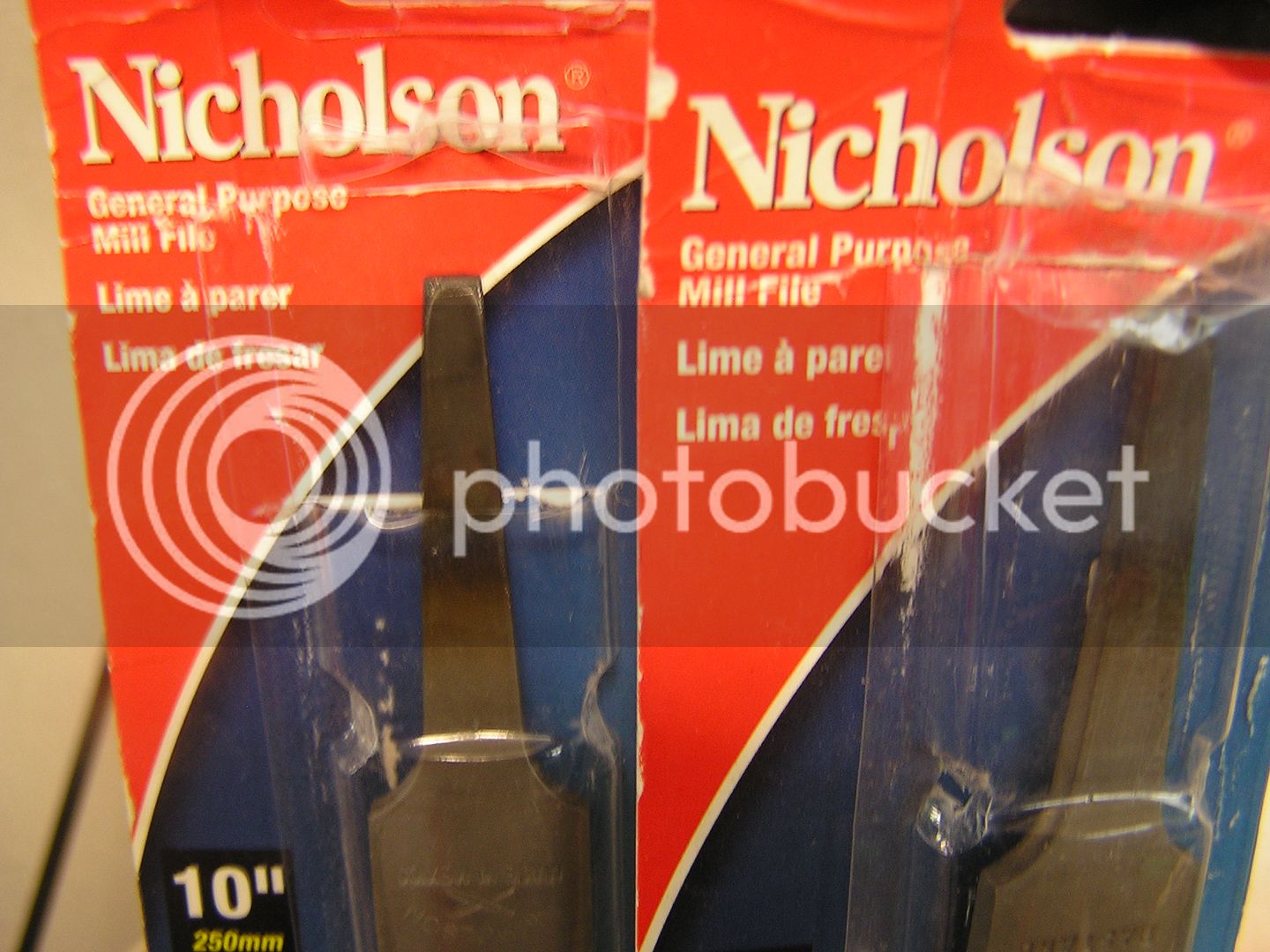
To get the lift needed on the harder brass bullets I changed to a slightly more course file using a General Purpose Flat file
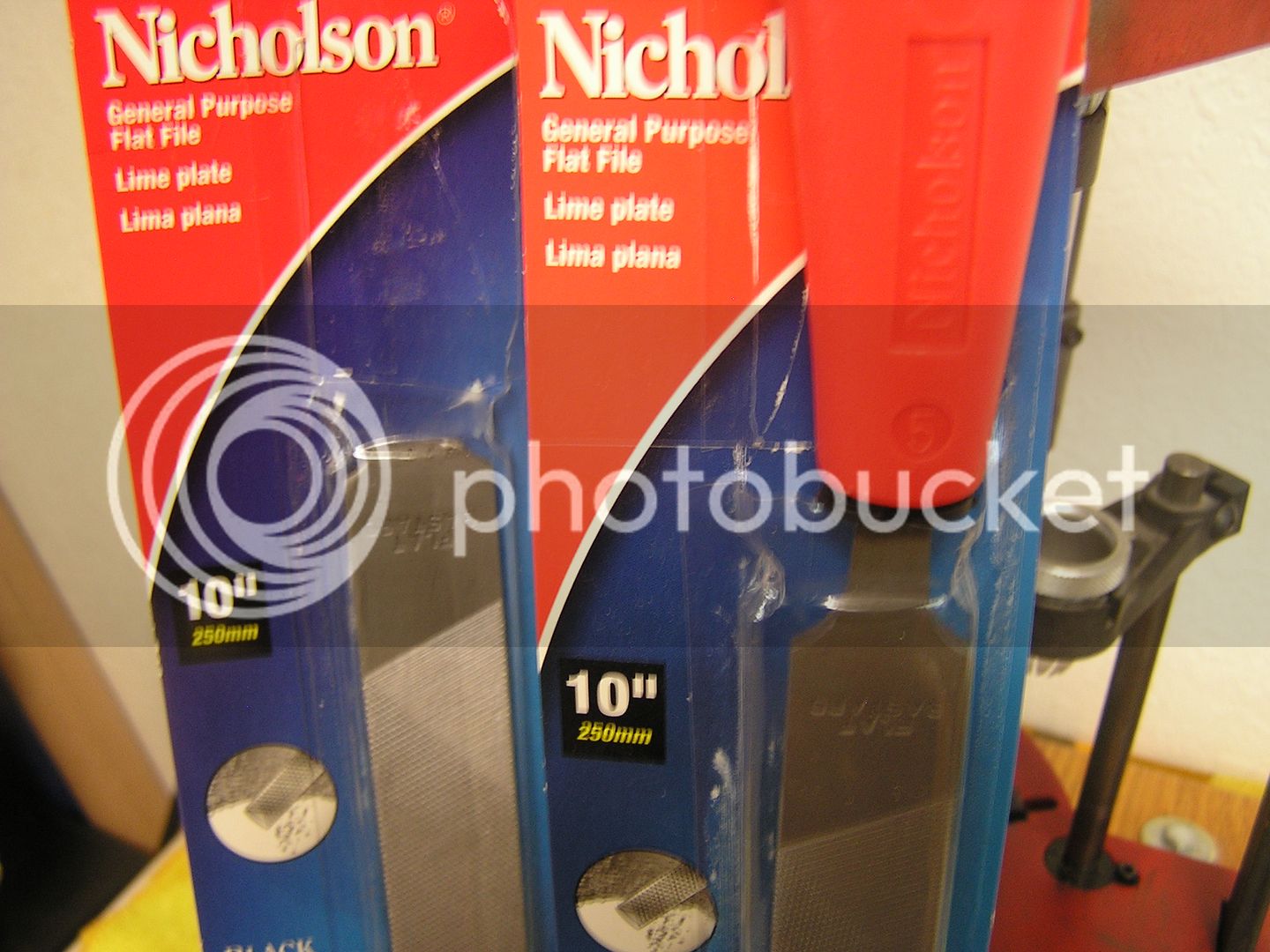
How much lift do really need? that really depends on the size of your bore and the bullet you choose to use in it. I would suggest to you that the bullet does not have to fit as tight as you might think to achieve stabilization and accuracy.
When I talked to Lehigh Dave about this project he suggested the a gentleman along time ago produced bullet that were called 'bore riders' they made very little contact with the bore and were extremely accurate. You might do a search for Lutz Moeller and look at his bullet offerings.
Using his general thoughts I knurl the Barnes and Lehigh to work pretty much on his principles. I do add a MMP Ballistic Sub-Bridge under the bullet (essentially a wad) to trap the gas behind the bullet. For myself the sub-bridge or sub-base provides a more positive gas seal than a wool wad or even a shot card might especially against the physical heat created by T7 or BH.
so how do I do it...
I place a piece of leather on a countertop and the file on top of the leather. The leather holds the bottom file in place. Then place the bullet to be knurled on the bottom file and the second file on top of the bullet.
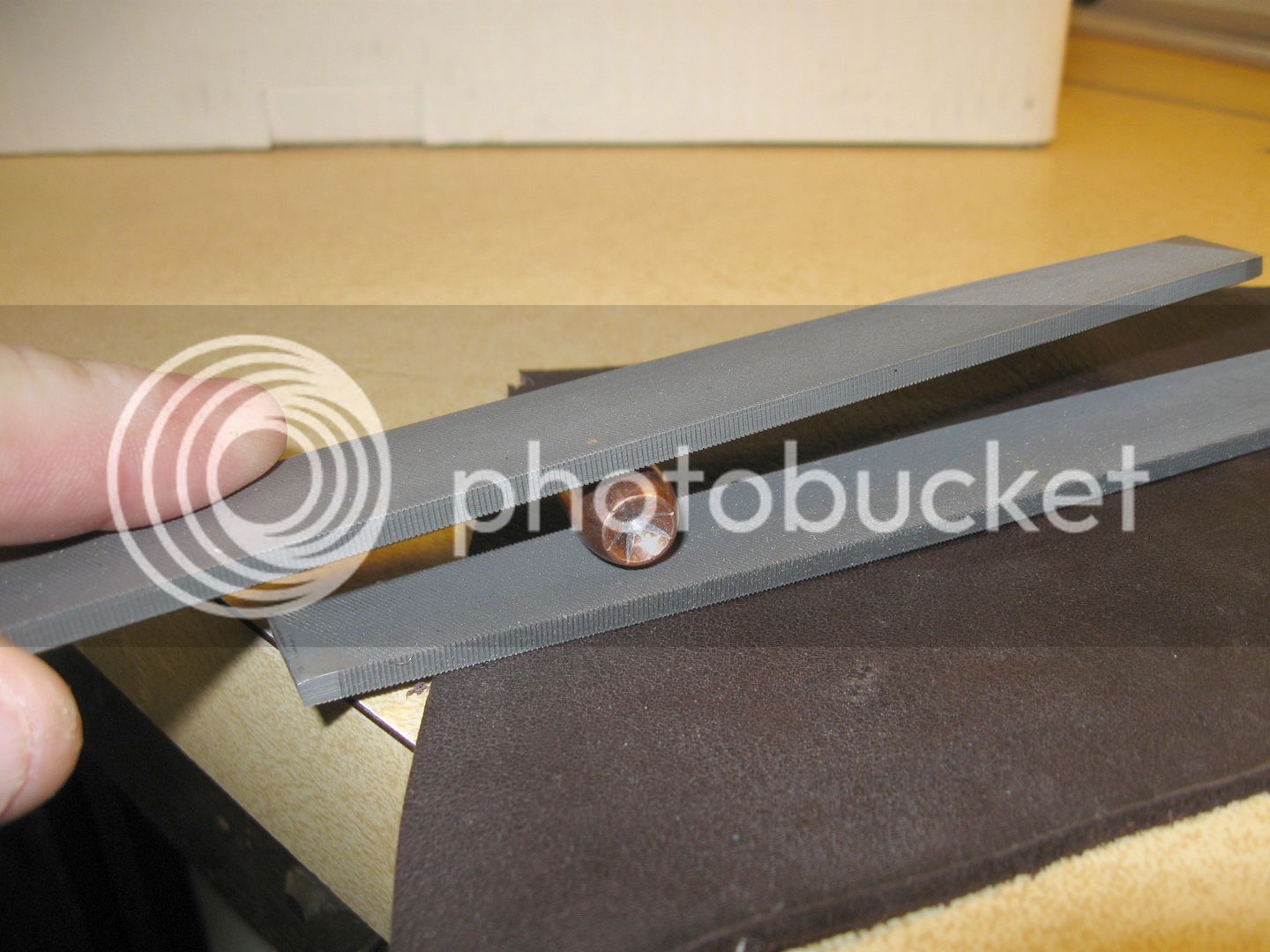
Then with heavy pressure applied to both ends of the top file I roll the bullet between the two files. The pressure displaces copper or brass creating a lift on the surface of the bullet.
These are Lehigh's that have undergone the lifting process.
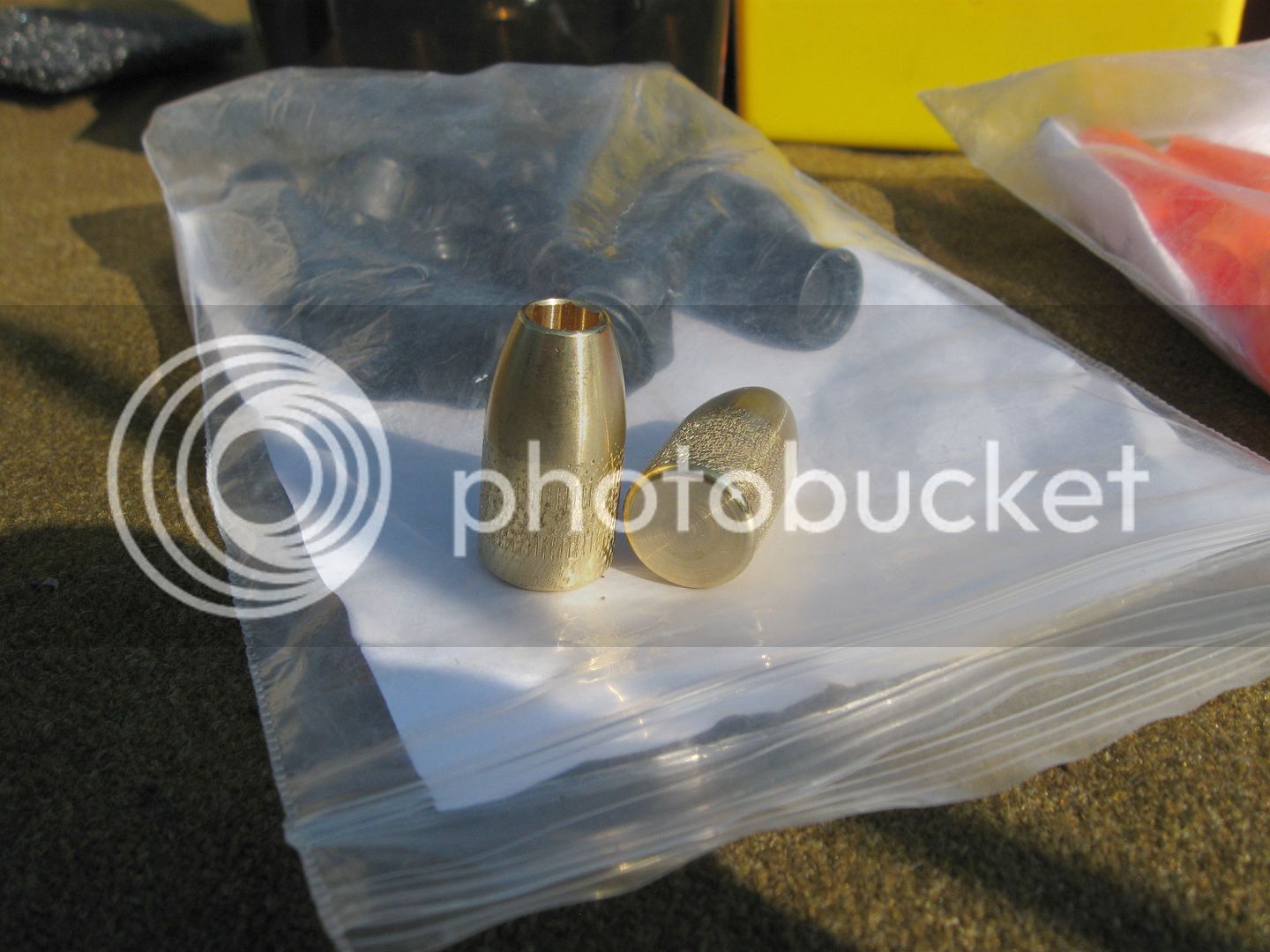
How many times you roll the bullet depends on the amount of lift you need. Stand the rifle by you knurling station. Remove the breech plug and drop the new bullet through. If it passes through rapidly to may need a lot of lift requiring more rolling. my suggestion is roll the bullet 3-4" on the files once and test it in the bore. You want enough lift that it will not pass through the crown of the bore.
When placing the bullet on the bottom file place it so the heel of bullet does not get knurled.
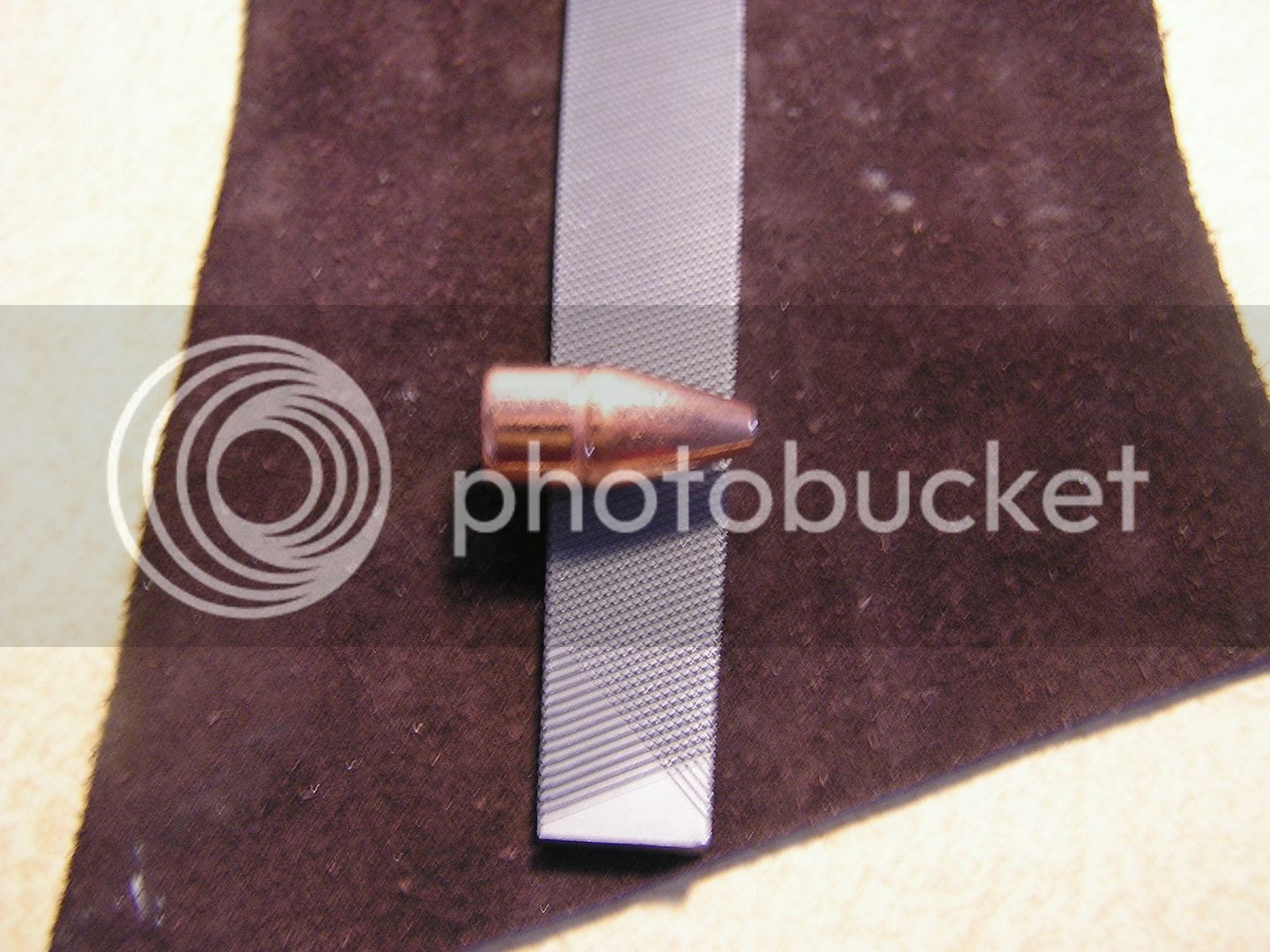
Place the top file on the bullet again with the heel extended out from between the files.
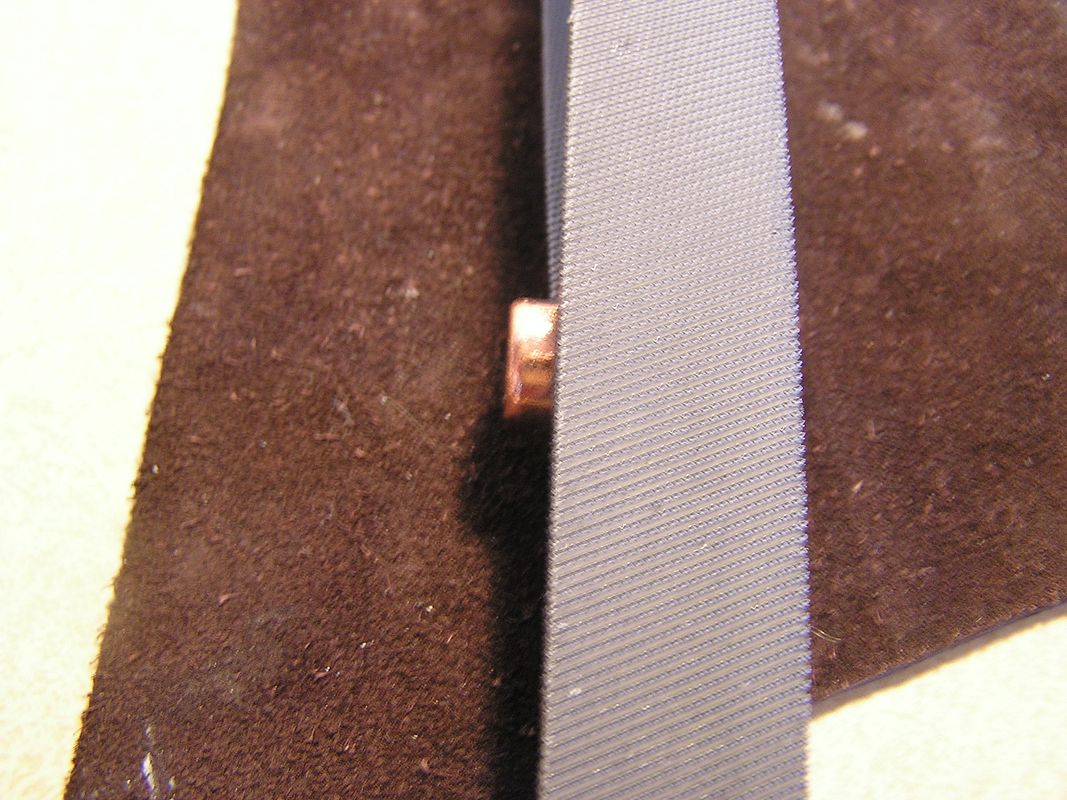
Leaving the heel clean will allow you to set the bullet in the crown of the bore and make it easier to push down either with a short starter or you ram rod. I believe it is very important to have knurling close to the heel of the bullet and all the way across the ogive of the bullet so that it goes down the bore evenly. This extend knurl will also insure the grip on the lands of the bore. And again heavy loading pressure is not needed for stabilization.
Place both hands on the top file and apply a heavy downward pressure on the bullet and roll it forward between the two files. Check the bullet in the crown and repeat the process until the needed amount of lift is achieved.
This bullet was rolled 3 times and placed in the crown it stopped going down at the knurling and is ready to be pushed through the crown,
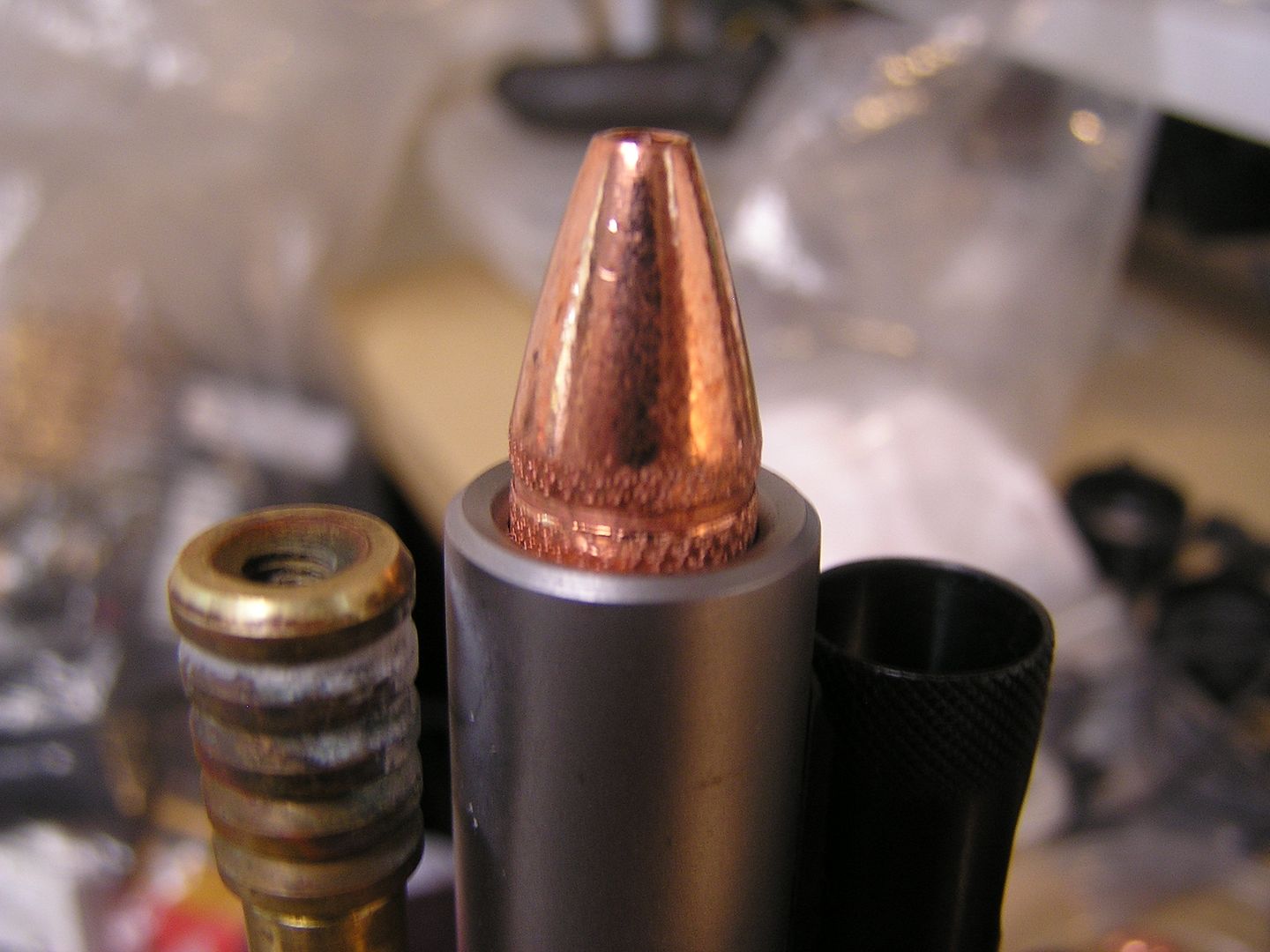
I would also suggest you do not to do many bullets until you are actually able to check the bullet by pushing it all the way through the bore.
Also I would start with copper bullets as they are more forgiving and will allow you to push a heavily knurled bullet through the bore especially with the aid of a short starter to get it through the crown.
Hope this helps some who might try this process.
I have been knurling bullets for the last couple years just using a couple of files to increase the diameter of a given bullet to allow it to load full in my ML's.
It all actually started with 0.5045 Bull Shop lead conicals that I was trying to use in my White Ultra-Mag. In my rifle I was a uncomfortable with the ease that they loaded and I worried about that heavy bullet possibly falling off the powder in the bore. The simple solution was to make the OD of the bullet slightly larger than it was. After asking some questions on different forums - I was told the easy answer is 'knurl' them between to files to create a lift in diameter by displacing some of the lead material. Running the bullets between two course files created the lift I needed. Knurling lead was really easy and best of all it was very forgiving. Even when I got to great of a lift loading pushing the soft lead through the crown was not a problem at all. Then the ignition of the powder would cause the soft lead bullet to obturate even more to the bore.
A few years ago in an attempt to shoot bull bore copper/lead bullets in the 50 became an interest. With the advent of the Desert Eagle and other newer 50 cal. weapons the availability of quality 50 cal. bullets became even greater. And there were some really good 50 cal. bullets on the market. Recently I have re-newed my interest and stated with Speer 50 cal. 300 grain deep curls. After that effort I turned to Barnes XPB pistol bullets. These all copper bullets required me to change files to a mill file to get a more even knurl and then with the Lehigh brass bullet I then changed to a General Purpose flat file that a bit more aggressive than the General Purpose Mill file.
This was the Mill file that I am using for Copper-lead or copper bullets to create the lift.

To get the lift needed on the harder brass bullets I changed to a slightly more course file using a General Purpose Flat file

How much lift do really need? that really depends on the size of your bore and the bullet you choose to use in it. I would suggest to you that the bullet does not have to fit as tight as you might think to achieve stabilization and accuracy.
When I talked to Lehigh Dave about this project he suggested the a gentleman along time ago produced bullet that were called 'bore riders' they made very little contact with the bore and were extremely accurate. You might do a search for Lutz Moeller and look at his bullet offerings.
Using his general thoughts I knurl the Barnes and Lehigh to work pretty much on his principles. I do add a MMP Ballistic Sub-Bridge under the bullet (essentially a wad) to trap the gas behind the bullet. For myself the sub-bridge or sub-base provides a more positive gas seal than a wool wad or even a shot card might especially against the physical heat created by T7 or BH.
so how do I do it...
I place a piece of leather on a countertop and the file on top of the leather. The leather holds the bottom file in place. Then place the bullet to be knurled on the bottom file and the second file on top of the bullet.

Then with heavy pressure applied to both ends of the top file I roll the bullet between the two files. The pressure displaces copper or brass creating a lift on the surface of the bullet.
These are Lehigh's that have undergone the lifting process.

How many times you roll the bullet depends on the amount of lift you need. Stand the rifle by you knurling station. Remove the breech plug and drop the new bullet through. If it passes through rapidly to may need a lot of lift requiring more rolling. my suggestion is roll the bullet 3-4" on the files once and test it in the bore. You want enough lift that it will not pass through the crown of the bore.
When placing the bullet on the bottom file place it so the heel of bullet does not get knurled.

Place the top file on the bullet again with the heel extended out from between the files.

Leaving the heel clean will allow you to set the bullet in the crown of the bore and make it easier to push down either with a short starter or you ram rod. I believe it is very important to have knurling close to the heel of the bullet and all the way across the ogive of the bullet so that it goes down the bore evenly. This extend knurl will also insure the grip on the lands of the bore. And again heavy loading pressure is not needed for stabilization.
Place both hands on the top file and apply a heavy downward pressure on the bullet and roll it forward between the two files. Check the bullet in the crown and repeat the process until the needed amount of lift is achieved.
This bullet was rolled 3 times and placed in the crown it stopped going down at the knurling and is ready to be pushed through the crown,

I would also suggest you do not to do many bullets until you are actually able to check the bullet by pushing it all the way through the bore.
Also I would start with copper bullets as they are more forgiving and will allow you to push a heavily knurled bullet through the bore especially with the aid of a short starter to get it through the crown.
Hope this helps some who might try this process.





